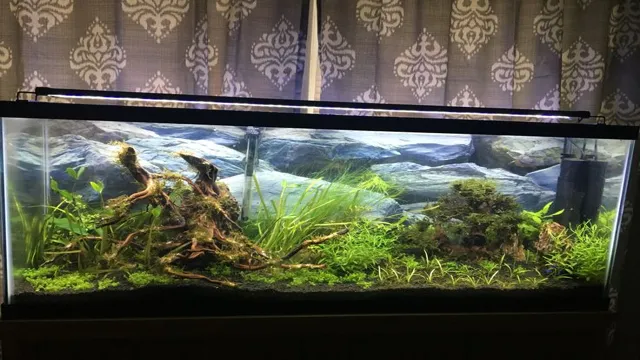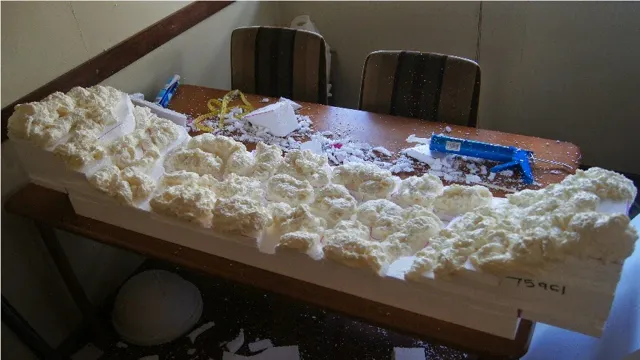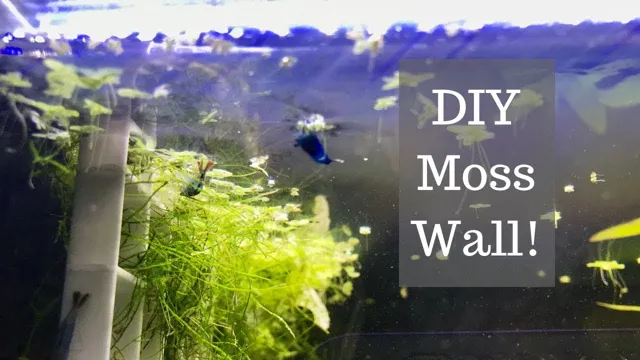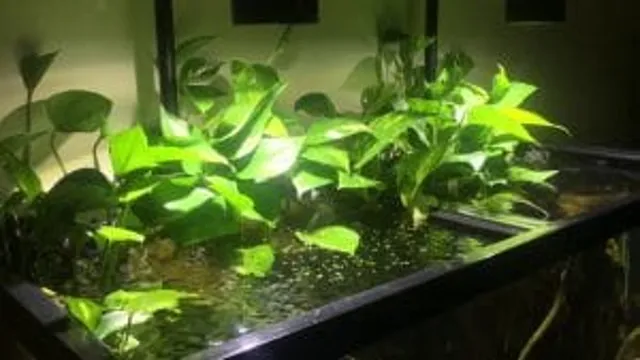Looking for a way to add a touch of nature to your home or office space? A DIY Plant Aquarium may just be the perfect solution you’ve been looking for! Not only does it allow you to create your own little ecosystem, but it also provides a visually stunning display that can liven up any room. A DIY Plant Aquarium is a living world that you create with your own hands. It’s a perfect way to exercise your creative muscles and make something beautiful and functional at the same time.
Imagine adding a pop of color to your space with colorful fish swimming among lush greenery. It’s almost like having your own private slice of paradise! Not only is a DIY Plant Aquarium visually pleasing, it offers a range of health benefits as well. Aquariums have been found to reduce stress and improve overall well-being.
They can also help to purify the air and create a calming effect in your environment. Creating a DIY Plant Aquarium is easier than you might think. With the right tools and a little bit of guidance, you can create a stunning display that will impress anyone who sees it.
Plus, it’s a great way to connect with nature and enjoy the benefits that come with having living plants and animals in your space. If you’re ready to create your own living world, then a DIY Plant Aquarium is the perfect way to do it. Let your creativity run wild and enjoy the beauty and benefits that come with having your own slice of nature right at home.
Benefits of a Plant Aquarium
If you’re a plant enthusiast looking for a new hobby, why not try making your own plant aquarium? Apart from being a visually appealing addition to your home decor, plant aquariums also provide a number of benefits. They act as natural air purifiers and can improve the humidity levels in your home. They can also provide a relaxing and calming atmosphere that can help to reduce stress and anxiety.
Creating one is easy, simply choose the right plants that work well in an aquatic environment, add the right substrate and lighting, and monitor the water temperature to ensure the plants thrive. A plant aquarium is a unique way to display your love for plants and a great conversation starter for any guest who visits your home. So why not give it a try and see the difference it can make in your life?
Improved Air Quality and Oxygenation
One of the benefits of having a plant aquarium is the improvement in air quality and oxygenation. The plants in your aquarium act as natural filters, removing harmful toxins and contaminants from the water, which helps to purify the air in your home. This can be particularly beneficial for those with allergies or respiratory issues.
Additionally, the plants in your aquarium release oxygen as a byproduct of photosynthesis, providing a fresh and healthy environment for both you and your aquatic pets. So not only does a plant aquarium add a beautiful touch to any room, but it also has tangible benefits for your health and well-being. By incorporating live plants into your aquarium, you are creating a miniature ecosystem that can promote a more natural and balanced environment.
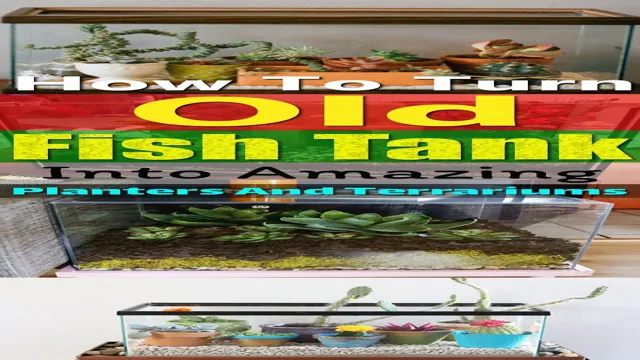
Reduced Stress and Anxiety Levels
One of the top benefits of having a plant aquarium is the reduced stress and anxiety levels it can provide. The soothing effect of watching fish swim gracefully amidst aquatic plants can help calm the mind and lower cortisol levels, which in turn can decrease stress and anxiety. By enhancing the overall ambiance of a room, a plant aquarium creates a sense of peace and tranquility, which can help alleviate symptoms of anxiety and depression.
Additionally, taking care of a plant aquarium can serve as a form of mindful meditation that promotes feelings of relaxation and wellbeing. So, if you’re looking to improve your mental health and create a serene atmosphere in your home or office, a plant aquarium may be just what you need.
Enhanced Aesthetics and Décor
A plant aquarium can be an excellent way to enhance the aesthetics and décor of any space. Beyond its obvious function as a unique accent piece, a plant aquarium offers a range of benefits that can make it an even more worthwhile investment. For one, the combination of live plants and underwater life can create a dynamic and visually appealing display that can captivate viewers of all ages.
Additionally, the presence of plants and fish can help to improve the air quality and overall vibe of any room. The plants act as natural air purifiers, helping to remove harmful toxins and pollutants, while the fish can have a calming effect on those who observe them. This can make plant aquariums a great option for areas that are prone to stress or anxiety, such as a home office or living room.
Overall, there are many good reasons to consider adding a plant aquarium to your space. By doing so, you can enjoy the beauty of nature from the comfort of your own home while also reaping the benefits of improved air quality and stress reduction.
Materials and Tools Required
If you want to make your own plant aquarium, there are a few materials and tools that you’ll need to get started. First, you’ll need a glass container that is large enough to hold plants, water, and fish (if you choose to include them). You can use a large vase, jar, or even a fish tank.
Next, you’ll need plants that can survive underwater, such as java fern, anubias, and cryptocoryne. You can purchase these from a local aquarium store or online. You’ll also need a substrate, or the material that goes on the bottom of the aquarium, such as gravel or sand.
Additionally, you’ll need an aquatic fertilizer to help the plants grow, as well as a light source. If you choose to add fish, you’ll need a filter, heater, and thermometer to maintain proper water conditions. With these materials and tools, you’ll be well on your way to creating a beautiful and thriving plant aquarium.
Aquarium Tank
If you’re planning to set up an aquarium tank for your fish, then there are a few key materials and tools you’ll need to have on hand. First and foremost, you’ll need a tank, which can be purchased at most pet stores. It’s important to select a tank that is appropriate for the number and size of fish you plan to keep.
You’ll also need a good filtration system to keep the water in the tank clean and healthy for your fish. This can include a power filter, air pump, and chemical filters. Other important tools and materials include a thermometer to monitor the temperature of the water, a heater to regulate the temperature, substrate such as gravel or sand for the bottom of the tank, decorations such as plants or ornaments, and a good quality fish food.
With these materials and tools on hand, you’ll be well on your way to setting up a beautiful and healthy aquarium tank for your fish to thrive in.
Gravel or Substrate
When it comes to aquariums, the choice between using gravel or substrate can be a tough decision to make. First off, it’s important to know that both materials will serve as a base for your aquarium and will help support your plants and fish. Gravel is the cheaper option and is readily available in a range of colors. (See Also: How to Cement Rocks in Aquarium: A Step-by-Step Guide to Secure Your Aquatic Decorations)
It’s easy to clean and allows water to circulate freely. Substrate, on the other hand, is more expensive and can come in different forms such as sand, aquarium soil, and crushed corals. It provides a more natural environment for aquatic plants and helps keep the pH level more stable.
Ultimately, the decision will come down to personal preference, the type of plants and fish you have, and the overall look you want to achieve. Whatever option you choose, make sure to properly prepare your substrate or gravel before adding it to your aquarium to avoid any unwanted debris or toxins.
Plants
When it comes to working with plants, there are a variety of materials and tools that may be needed depending on the task at hand. One of the most essential tools is a pair of sturdy gloves, as many plants have thorns or other sharp parts that can easily cause injury. Pruning shears or scissors are also important for shaping and maintaining plants, while a trowel or other digging tool may be necessary for planting new ones.
Other potential materials include soil, fertilizer, watering cans or hoses, and stakes or trellises to support a plant’s growth. It’s important to have a good understanding of the specific needs and requirements of the plants you’re working with, as certain tools and materials may be more or less appropriate depending on the situation. By stocking up on the right materials and tools, you can ensure that your plants are healthy, thriving, and beautiful.
Lighting
When it comes to lighting, there are some basic materials and tools that you’ll need to get started. The first thing you’ll need is a light fixture, which can come in a variety of styles and sizes. Some popular types include chandeliers, pendant lights, and flush-mount fixtures.
You’ll also need light bulbs, and the type you choose will depend on the type of fixture you have. LED bulbs are a popular choice for their energy efficiency and long lifespan. You’ll also need wire cutters and wire strippers, as well as electrical tape and wire nuts for connecting the wires of your fixture.
A ladder or step stool may also come in handy, especially if you’re installing a fixture on a high ceiling. With these basic materials and tools, you’ll be well on your way to creating the perfect lighting scheme for your home or office space.
Filter and Water Heater (Optional)
If you want to take your hydroponics setup to the next level, adding a filter and water heater can be great options. The filter helps keep your water clean, removing any debris or impurities that could harm your plants. Meanwhile, the water heater helps maintain the ideal temperature for your plants to thrive, allowing you to grow a wider range of crops.
To set up the filter, you’ll need an appropriate filter system and some tubing to circulate water through it. The water heater requires a heater unit and a thermometer to ensure you maintain the ideal temperature range. With these additions, you can ensure your hydroponics system runs smoothly, keeping your plants happy and healthy.
Steps to Create a Plant Aquarium
If you want to create your own plant aquarium, it’s actually quite easy to do! The first step is to choose the right size tank for the space you have available and the number of plants you want to include. Next, you’ll need to install a filtration system to keep the water clean and aerated. Then comes the fun part – choosing the right plants! Some great options for a plant aquarium include Java fern, anubias, and Amazon sword.
Make sure to plant them in a high-quality substrate that will provide them with the right nutrients. Finally, add some decorations like rocks or driftwood to create a more natural environment for your plants. With a little time and effort, you can have your very own beautiful and thriving plant aquarium right in your own home!
Prepare the Tank and Add Substrate
When setting up a plant aquarium, the first step is to prepare the tank and add substrate. This involves thoroughly cleaning the tank with warm water and vinegar to remove any debris or chemicals. Rinse the tank several times to ensure that it’s completely clean.
Once the tank is clean, it’s time to add the substrate. You should choose a substrate that is specifically designed for planted aquariums, as it provides the necessary nutrients for your plants to thrive. A good substrate should be deep enough for your plants to root and have good water circulation.
It’s important to layer the substrate evenly across the bottom of the tank, ensuring that it’s deep enough for your plants to properly root. Once the substrate is in place, you can fill the tank with water. It’s important to fill the tank slowly to avoid disturbing the substrate.
With the substrate in place and the tank filled with water, you’re ready to move on to the next step in setting up your plant aquarium. Remember to choose a high-quality substrate for the best results and healthy plant growth.
Arrange the Plants and Add Water
Creating a plant aquarium is a fun and rewarding experience that allows you to showcase your favorite aquatic plants. Once you’ve chosen the plants you want to include, it’s time to arrange them in the aquarium. Begin by placing the largest plants in the back of the tank, followed by the medium-sized plants in the middle and the smallest plants in front.
This will create a sense of depth and dimension in your aquarium. Additionally, it’s important to add water carefully, so as not to disturb the plants or the substrate. Pour the water slowly and gently, filling the tank to the desired level.
As you add water, be sure to remove any debris or dirt that may have accumulated in the tank. With your plants arranged and water added, you’re well on your way to creating a stunning and thriving plant aquarium. Remember, caring for your aquatic plants requires regular maintenance, including pruning, feeding, and water changes.
By doing so, you’ll be able to enjoy your beautiful plant aquarium for years to come. (See Also: How to Decrease Ammonia Levels in Aquarium: Tips and Tricks for a Healthy Tank)
Install Lighting and Equipment
Creating a plant aquarium requires not just a good substrate and plants, it also necessitates the installation of lighting and equipment. First, investing in good quality LED lighting can change the game for your plant aquarium. LED lights are energy-efficient and have a longer lifespan.
It would also be helpful to research the appropriate lighting for the plants you have chosen. You can also add filters to keep the water clean and remove any potential toxins. Additionally, installing a CO2 injection system will help supplement the plant’s needs for this essential gas, and provide healthier oxygen levels.
The right equipment can ensure the longevity of the plants in your aquarium and create an optimal environment for them to thrive. A balanced aquarium with the appropriate lighting, filters, and CO2 system can mean a stunning and healthy plant aquarium display for years to come.
Cycle the Tank and Maintain Water Quality
Creating a plant aquarium may seem like a daunting task, but with the right steps, it can be a rewarding and relaxing project. One of the essential steps in establishing a successful plant aquarium is cycling the tank. This process involves introducing beneficial bacteria to convert harmful ammonia into nitrite and ultimately into nitrate.
It is crucial to maintain water quality throughout by performing regular water changes and using appropriate filtration systems to ensure optimum water conditions for the plants to flourish. Testing the water regularly with a water test kit can help keep the water parameters in check. Proper lighting and the correct substrate for the plants’ needs are also crucial to their growth and survival.
With patience, attention to detail, and care, creating a beautiful and healthy plant aquarium can be an enjoyable experience and a stunning addition to any room in your home.
Tips and Tricks for a Thriving Plant Aquarium
Making your own plant aquarium has become a popular hobby for many home gardeners. To create a thriving plant aquarium, you need to know a few important tips and tricks. First, choose a tank size based on the size and number of plants you want to grow.
Make sure the tank has a strong filter system to remove any buildup of ammonia and nitrates. Next, choose plants carefully based on their light, temperature, and nutrient requirements. Some popular aquarium plants include Java fern, Amazon sword, and Anubias.
Additionally, use a high-quality substrate to provide nutrients and anchor the plants. Add fish to the aquarium, but be careful not to add too many, as overcrowding can lead to excess waste which can harm your plants. Overall, creating a plant aquarium can be a fun and rewarding project that allows you to bring a little bit of nature into your home.
So, gather your materials and dive into making your own plant aquarium.
Choose the Right Plants and Lighting
One of the keys to maintaining a thriving plant aquarium is to choose the right plants and lighting. When selecting your plants, it’s important to consider the specific needs of each species. Some plants require high levels of light, while others prefer lower levels.
It’s also important to choose plants that are well-suited for the size of your aquarium. If you have a small tank, it’s better to choose smaller plants that won’t overcrowd the space. When it comes to lighting, there are a few things to keep in mind.
First, make sure that your lighting is appropriate for the type of plants you have. Second, it’s important to provide a consistent amount of light each day. Plants need a balance of light and darkness, so it’s important to avoid leaving your lights on for too long.
By choosing the right plants and lighting for your aquarium, you can create a beautiful and healthy environment for your fish and plants to thrive in.
Maintain Proper Tank Conditions and Water Parameters
Maintaining proper tank conditions and water parameters is crucial for the growth and health of a thriving plant aquarium. Firstly, it’s important to avoid overcrowding your tank as it can lead to poor water quality and lack of oxygen for your plants. Additionally, ensure that your tank receives adequate lighting to encourage photosynthesis, which is essential for plant growth.
Water temperature also plays a vital role, with most aquatic plants preferring warmer water temperatures. A pH level between 5 to
5 is ideal for most plants, but it’s recommended to research the specific requirements of the plants in your aquarium. Regular water changes are necessary to remove excess nutrients and waste that can accumulate and harm your plants. Lastly, utilizing a high-quality plant fertilizer can help provide the necessary nutrients for plant growth and help prevent algae growth.
By following these tips and maintaining proper tank conditions and water parameters, you can enjoy a thriving and healthy plant aquarium.
Provide Adequate Nutrients and CO2
If you want to keep your aquatic plants healthy and beautiful, you need to provide them with adequate nutrients and CO These elements are essential for photosynthesis, which is the process that plants use to convert light into energy. In a plant aquarium, you can use substrate fertilizers, liquid fertilizers, and CO2 injection systems to provide your plants with the nutrients and CO2 they need to thrive. (See Also: How to Circulate Water in Aquarium: A Comprehensive Guide for Beginners)
Substrate fertilizers are added to the bottom of the aquarium, and they release nutrients slowly over time. Liquid fertilizers are added directly to the water, and they provide a quick boost of nutrients. CO2 injection systems add CO2 directly to the water, which helps to increase the rate of photosynthesis.
The key is to find the right balance of nutrients and CO2, and to monitor your plants closely to ensure they are growing at a healthy pace. By following these tips and tricks, you can have a thriving plant aquarium that is both beautiful and healthy.
Regular Pruning and Cleaning
If you want your plant aquarium to flourish, then regular pruning and cleaning is a must. It’s important to stay on top of things and remove any dead or decaying foliage. This not only keeps your aquarium looking neat and tidy, but it also helps prevent any potential issues with water quality.
When you prune your plants, it allows for fresh new growth, which is essential for their overall health. A clean tank also means that your fish will thrive, and it creates a more pleasant environment for you to enjoy. Think of it like pruning a beautiful garden – the more you tend to it, the more beautiful it becomes.
So, set aside some time each week to give your plant aquarium the attention it deserves, and watch it thrive!
Final Thoughts: Embrace the Living Beauty of a Plant Aquarium
Creating your own plant aquarium can seem daunting at first, but it’s a lot easier than you might think. Not only is it a fun DIY project, but having a plant aquarium can add a beautiful living element to your home or office space. To get started, you’ll need an aquarium tank, substrate, and plants.
It’s important to choose plants that are suitable for an aquatic environment—researching the different species and their care requirements can help you select the right ones. Some popular plant choices include java fern and anubias. When adding plants to your aquarium, make sure to bury their roots in the substrate and avoid damaging them in the process.
A good lighting and fertilization setup can help your plants thrive. Remember, creating a plant aquarium is a learning experience, so don’t be afraid to make mistakes and adjust along the way. By embracing the beauty of a plant aquarium, not only will you add a stunning visual element to your space, but you’ll be taking care of a living ecosystem that can bring you joy for years to come.
Conclusion
So there you have it, folks! Making your own plant aquarium is a fun and easy way to bring a bit of underwater magic to your home. With just a few simple steps, some plants, and a bit of creativity, you can create a beautiful and thriving ecosystem that will provide joy and relaxation for years to come. And who knows, maybe your skills will even lead to a lifelong passion for marine biology or aquascaping – but remember, always keep your water parameters in check, or else you’ll be seeing more algae than Nemo!”
FAQs
What are the benefits of having a plant aquarium at home?
A plant aquarium can improve indoor air quality, reduce stress, and enhance the overall aesthetic appeal of your home.
What kind of plants are suitable for a plant aquarium?
Plants that thrive in low-light and water conditions such as Anubias, Java Ferns, and Amazon Swords are ideal for plant aquariums.
How do you set up a plant aquarium?
Firstly, choose the right size and location for your aquarium. Then, add a layer of substrate and place rocks or driftwood as a decoration. Finally, plant the aquatic plants and fill the aquarium with water.
How often should you water the plants in a plant aquarium?
As the plants are submerged in water, there is no need to water them. However, you should ensure that the water is sufficiently oxygenated by using a filter or doing regular water changes.
How do you maintain a plant aquarium?
Regular maintenance includes checking and maintaining the water parameters, trimming overgrown plants, and cleaning the aquarium glass and decorations.
Can fish and shrimp coexist in a plant aquarium?
Yes, some species of fish and shrimp can coexist in a plant aquarium, but you need to ensure that the water parameters, tank size, and plants are suitable for both.
Can you grow edible plants in a plant aquarium?
Yes, some plants such as watercress, water spinach, and water chestnut can be grown in a plant aquarium. However, you need to ensure that the water and tank are free from contaminants and safe for consumption.

